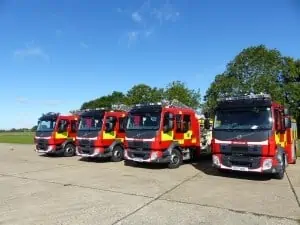
The next generation of fire engines is now starting to serve in the Thames Valley following a successful 18-month collaborative project run in a partnership between Buckinghamshire & Milton Keynes Fire and Rescue Service, Oxfordshire County Council Fire and Rescue Service and Royal Berkshire Fire and Rescue Service.
Their collaborative work has delivered fire engines which include the latest innovation and technological advances, and also further align working practices between firefighters in the Thames Valley.
During the project a joint procurement exercise and rigorous testing process were held, resulting in the agreement of a contract for a total of 37 new fire engines over the next four years.
Fifteen vehicles have been ordered in the first year of the four-year contract, with eight for Buckinghamshire, three for Oxfordshire and four for Royal Berkshire. The vehicles will be located at stations close to the three services’ shared borders and replace existing vehicles.
Four of the new vehicles were on display during an event which was held at Abingdon Airfield on Wednesday, 13 September.
The new fire engines were built by Emergency One (UK) Ltd on Volvo FL 42R chassis. The 15-tonne vehicles symbolise the high levels of collaboration which have been achieved by the three services since the establishment of a shared Thames Valley Fire Control Service and the signing of a Memorandum of Understanding in 2015.
The enormous amount of work that has been undertaken by staff to bring the project to fruition also underlines the three services’ commitment to the fire reform agenda.
As well as enabling the services to modernise their fleets and equipment and increase resilience levels, the project is expected to achieve combined savings from buying in bulk of about £720,000, both in terms of equipment and the new fire engines.
Councillor Angus Ross, Royal Berkshire Fire Authority’s Lead Member for Strategic Assets, said: “We are delighted to unveil a series of modern, fit-for-purpose fire engines with all the associated equipment that complements our existing fleet of vehicles and allows us to deliver an improved service for all of our communities.
“The new fire engines have been equipped with larger hose reels to enable higher rates of water delivery and they carry more battery powered equipment, to increase our speed of deployment at an incident and reduce the total weight of the vehicle. Training our crews on using the equipment will become easier and more cost effective as we align our ways of working with the other fire and rescue services.”
Councillor Roger Reed, Chairman of Buckinghamshire & Milton Keynes Fire Authority, said: “By working closely with our Thames Valley fire and rescue service partners in the procurement exercise, we have been able to increase the efficiency of our fleet.
“Not only has this resulted in making our money go further, but it also means that our crews can work seamlessly together with our partners. Resources can be better shared at incidents and we can better align our training and procedures to the same standards and requirements as our counterparts moving forward.”
Councillor Judith Heathcoat, Deputy Leader of Oxfordshire County Council and the cabinet member for Oxfordshire Fire and Rescue Service, said: “This project has built upon the collaboration that has been going on for a number of years between the three fire and rescue services, including the move to a shared Thames Valley Fire Control Service in 2015.
“This is an excellent example of public sector collaboration which is not only an effective and efficient way of working, but a moral duty to help protect the communities we serve. It further embeds shared working practices and allows us to better align our response to ensure our communities receive an effective response no matter which side of the county border they live in.”
The project paves the way for standardised inventories and shared operating procedures across the three services. This will be particularly beneficial when crews are responding to cross-border incidents and also make it easier for the Services to deliver shared training packages for their crews.
One of the key design principles was to make the appliances as universal as possible so that crews across the three services could operate each other’s fire engines seamlessly, if needed.
The project produced a specification featuring a number of improvements, along with the latest innovation and technological advances, including:
- Larger (22mm) hose reels to enable water to be delivered more quickly to extinguish fires.
- Battery-powered extrication equipment, which is easier to carry and less bulky than hydraulic equipment, eliminates potential hydraulic hose hazards and removes generator noise from rescue situations.
- Improved mobile lighting for better visibility at the scene of an incident.
- A more comfortable seating area for crews. This is especially important as firefighters are typically spending more time in the fire engine, completing prevention work such as Home Fire Safety Checks (HFSCs).
Appliance specification detail
- Make: Volvo.
- Model: FL 42R, with extended crew cab.
- Wheelbase: 4.40m.
- Overall Length: 8.20m.
- Overall Width: 2.90m.
- Clearance Height: 3.30m.
- Engine: Volvo EURO VI, 7,698cc, 280hp.
- Coach builder: Emergency One (UK) Ltd.
- Plastic body with integral 1800L water tank and 100L foam tank.
- Fire pump: Godiva Prima P2 3010 (3000 L/min) with integral RTP AFFF system and ePump control.
- Two hose reels each c/w 3x20m lengths of 22mm hose reel tubing.